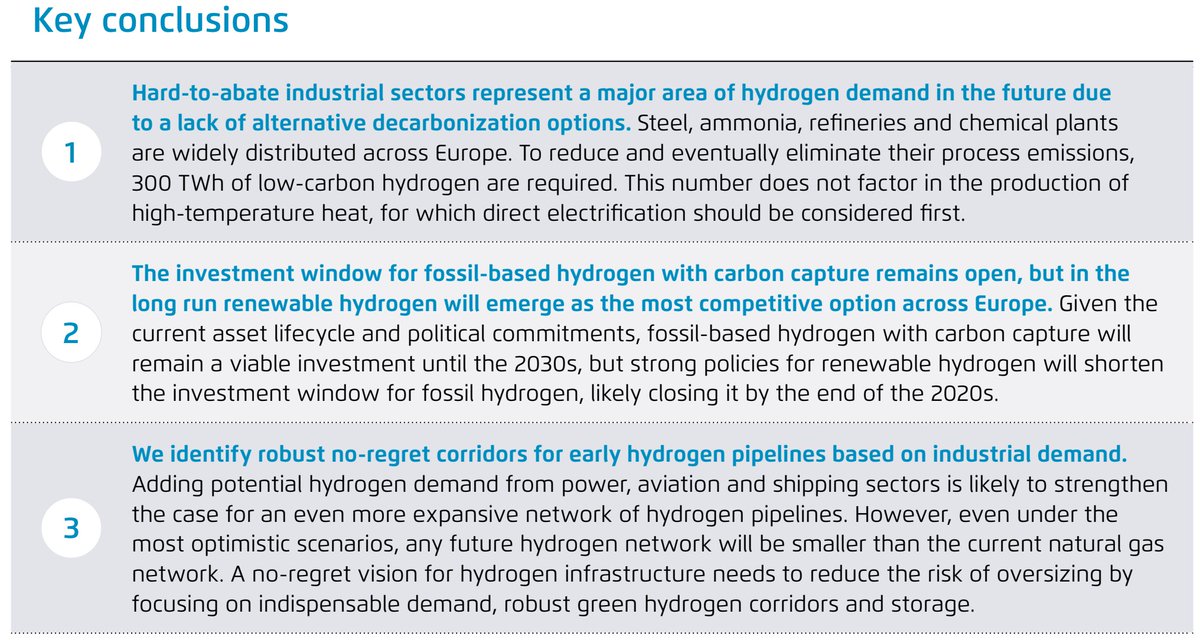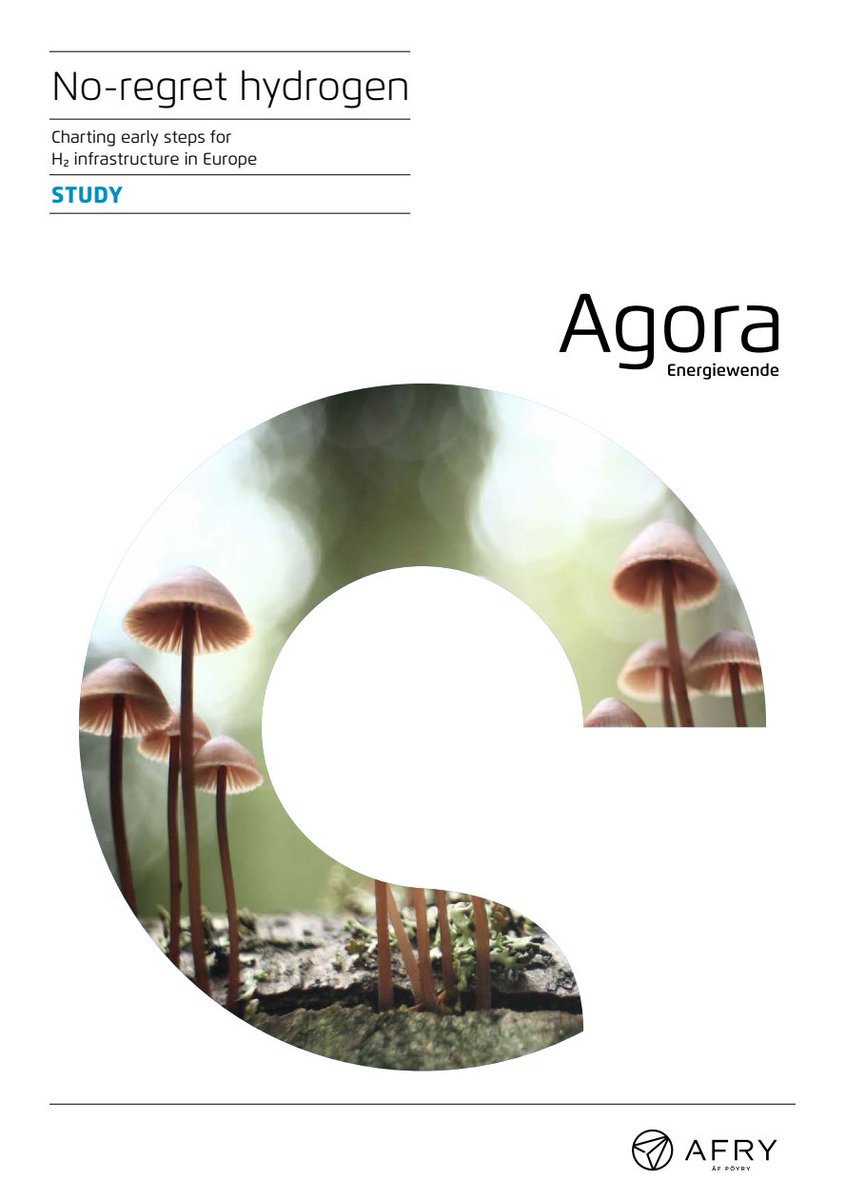#Hydrogen production via electrolysis needs a large number of full-load hours to be economical, and #offshorewind promises just that.
But there is a caveat - and new evidence.
Let me explain… 🧵 👇
1/
But there is a caveat - and new evidence.
Let me explain… 🧵 👇
1/

Europe will need a lot of #hydrogen for those no-regret applications that really require it to become climate-neutral:
in industry, in long-haul aviation & shipping, in the power sector as seasonal storage for backing up renewables & in heat grids.
2/
in industry, in long-haul aviation & shipping, in the power sector as seasonal storage for backing up renewables & in heat grids.
2/

Offshore wind is expected to contribute substantially to meeting Europe‘s #hydrogen needs and it promises high full-load hours.
For example, the IEA assumed
~3500 to 5300 full-load hours in its 2021 report.
And there are many other similar estimates.
3/
For example, the IEA assumed
~3500 to 5300 full-load hours in its 2021 report.
And there are many other similar estimates.
3/

But: The more turbines are installed in a region, the less efficient #offshorewind production becomes due to a lack of wind recovery.
That is, full-load hours get reduced.
4/
That is, full-load hours get reduced.
4/

So if you plan for a major #offshorewind expansion, bear in mind two things:
- the total wind farm area and
- the installed capacity density.
Both matter.
5/
- the total wind farm area and
- the installed capacity density.
Both matter.
5/
The number of full-load hours goes down with larger wind farm area and higher capacity density.
(See the declining "relative efficiency" in the diagram.)
And this effect now shows up in the German draft Site Development Plan for #offshorewind...
6/
(See the declining "relative efficiency" in the diagram.)
And this effect now shows up in the German draft Site Development Plan for #offshorewind...
6/

Germany aims for 70 GW #offshorewind by 2045, and the recently published draft Site Development Plan covers ~ 60 GW and installed capacity densities from 7 to 12 MW/km².
👉Resulting total full-load hours: 3400.
bsh.de/DE/THEMEN/Offs…
7/
👉Resulting total full-load hours: 3400.
bsh.de/DE/THEMEN/Offs…
7/

So what can be done to mitigate such a reduction in full-load hours ❓
8/
8/
Countries on the North and Baltic Seas should cooperate with a view to maximizing the wind yield and full-load hours of their #offshorewind farms.
9/
9/

And we need a new kind of maritime spatial planning that considers the adjusted wind climate due to kinetic energy extraction by wind farms.
Otherwise, we risk bad surprises for the production of both electrons and molecules.
10/
Otherwise, we risk bad surprises for the production of both electrons and molecules.
10/

Note the new approach of thinking synergistically about maritime areas:
We need
(1) areas for harvesting wind energy, as well as
(2) areas for replenishing (!) wind speeds.
11/
We need
(1) areas for harvesting wind energy, as well as
(2) areas for replenishing (!) wind speeds.
11/
If you want to learn more about the reduction in full-load hours, check out our publication with modeling by DTU and MPI-BGC:
agora-energiewende.de/en/publication…
12/
agora-energiewende.de/en/publication…
12/

It comes with several appendices for download, including a model:
13/
https://twitter.com/Ma_Deutsch/status/1234574995445178371
13/
@gnievchenko @PhilippLitz @finmuc_schmidt
@PhHauser @Ben_Pfluger @EnergyRuud
@kirstenwestpha1 @YanaZabanova @anunezjimenez @EBiancoIT @JMGlachant @nworbmot @andiwagner @FalkoUeckerdt @ChristianOnRE @hansDambeck @UrsMaier @EvaCSchmid @J_Wettengel
@Jose_EnergyCC @C_Pellinger
14/
@PhHauser @Ben_Pfluger @EnergyRuud
@kirstenwestpha1 @YanaZabanova @anunezjimenez @EBiancoIT @JMGlachant @nworbmot @andiwagner @FalkoUeckerdt @ChristianOnRE @hansDambeck @UrsMaier @EvaCSchmid @J_Wettengel
@Jose_EnergyCC @C_Pellinger
14/
@WindEurope @OffshoreWINDbiz @OEUK_ @GWECGlobalWind @EUREC_Info @BWO_news @OffshoreWindH2 @GTGascade @GasforClimate @H2Europe @gh2org @hydrogen @MissionHydrogen
@DWindGuard @MarcoWuensch @jakebadger @akleidon
15/
@DWindGuard @MarcoWuensch @jakebadger @akleidon
15/
@maobelaunde @ThatManZaf @paulmuennich @Fabar021 @emirc1907 @janke_leandro @Carolin45531148 @Isadora_atAgora @praliinn @PhilDHauser @KWitecka @_camillaoliv @JuliaChMetz @CitizenSane1 @andreasgraf
@FraPe0101 @SimonGMueller
16/
@FraPe0101 @SimonGMueller
16/
• • •
Missing some Tweet in this thread? You can try to
force a refresh











